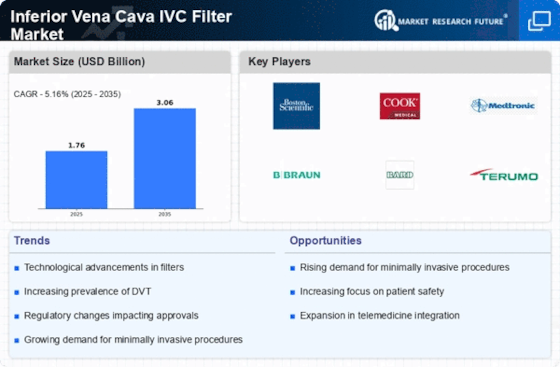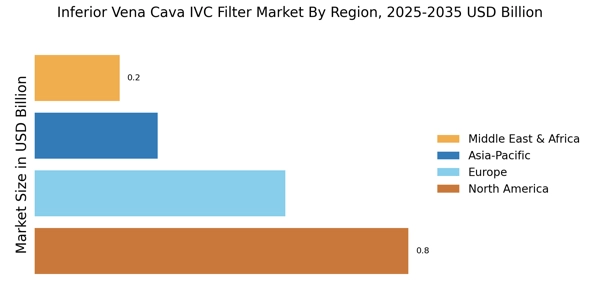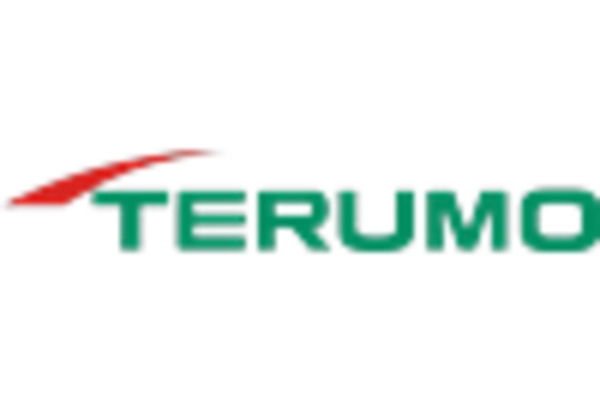Rising Healthcare Expenditure
The increase in healthcare expenditure across various regions is a crucial driver for the Inferior Vena Cava IVC Filter Market. As healthcare budgets expand, there is a greater focus on preventive measures and advanced medical technologies. This trend is evident in many countries, where investments in healthcare infrastructure and technology are on the rise. The allocation of funds towards innovative medical devices, including IVC filters, reflects a commitment to improving patient care and outcomes. Consequently, as healthcare systems prioritize the management of VTE risks, the demand for IVC filters is expected to grow, indicating a positive trajectory for the market.
Increasing Geriatric Population
The growing geriatric population is a significant factor propelling the Inferior Vena Cava IVC Filter Market. As individuals age, the risk of developing conditions such as VTE increases, necessitating preventive measures like IVC filters. The World Health Organization projects that the number of people aged 60 years and older will reach 2 billion by 2050, highlighting a substantial market opportunity. This demographic shift is prompting healthcare systems to adapt and provide effective solutions for managing VTE risks in older adults. Consequently, the demand for IVC filters is likely to rise, as healthcare providers seek to address the unique needs of this population, thereby driving market expansion.
Regulatory Support and Guidelines
Regulatory bodies are increasingly focusing on the safety and efficacy of medical devices, including IVC filters, which is positively impacting the Inferior Vena Cava IVC Filter Market. Guidelines and recommendations from health authorities encourage the use of IVC filters in specific patient populations, particularly those at high risk for VTE. This regulatory support not only enhances the credibility of IVC filters but also promotes their adoption in clinical practice. As healthcare providers align with these guidelines, the market is likely to experience growth. Furthermore, ongoing research and post-market surveillance initiatives are expected to lead to improved product offerings, further stimulating market dynamics.
Technological Innovations in IVC Filters
Technological advancements in the design and functionality of IVC filters are significantly influencing the Inferior Vena Cava IVC Filter Market. Innovations such as retrievable filters, which can be removed after the risk of VTE has passed, are gaining traction. These advancements not only improve patient outcomes but also reduce the risk of long-term complications associated with permanent filters. The market has seen a shift towards filters that are easier to implant and remove, which is likely to enhance their adoption. Furthermore, the integration of imaging technologies for better placement accuracy is expected to bolster market growth. As these technologies evolve, they may lead to increased confidence among healthcare providers in utilizing IVC filters.
Rising Incidence of Venous Thromboembolism
The increasing prevalence of venous thromboembolism (VTE) is a primary driver for the Inferior Vena Cava IVC Filter Market. VTE, which includes deep vein thrombosis and pulmonary embolism, affects millions worldwide. According to recent estimates, the incidence of VTE is approximately 1 to 2 per 1,000 individuals annually. This rising incidence necessitates effective preventive measures, including the use of IVC filters, particularly in high-risk patients. As healthcare providers seek to mitigate the risks associated with VTE, the demand for IVC filters is expected to grow. This trend is further supported by advancements in filter technology, which enhance safety and efficacy, thereby driving the market forward.


















Leave a Comment